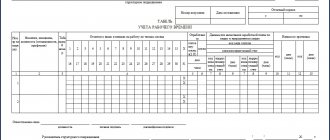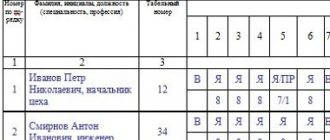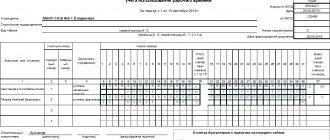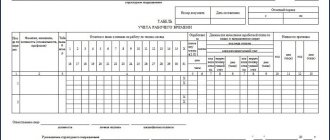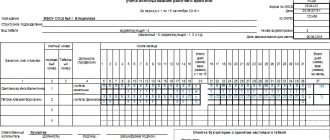Home / Labor Law / Personnel Management / Personnel Records
Back
Published: 08/25/2016
Reading time: 7 min
0
3723
In different cases, the employee sometimes needs a copy of the time sheet. Usually such a document is issued in the form of an extract. Let's find out how to get it and how to apply it correctly.
- What is a time sheet?
- Document Sections
- Why do you need a copy?
- Can I get a copy of the report card?
- Structure and sample statement
Why do you need a time sheet?
Employers are required to keep records of the working time of their employees (Part 3 of Article of the Labor Code of the Russian Federation).
For commercial organizations there are special unified forms of accounting sheets No. T-12 and T-13, they are approved by State Statistics Committee Resolution No. 1 dated January 05, 2004. The time sheet records information about the time actually worked, the number of absences during the month for each employee. The time sheet is the basis for settlements with employees. Based on it:
- keep records of the average number of employees;
- calculate and calculate salaries;
- calculate average earnings for the period of vacation or business trip;
- accrue social benefits;
- control the payment of personal income tax and contributions;
- generate statistical reporting
The tax or labor inspectorate may request a report card during an inspection. In addition, the employer is obliged to issue it upon dismissal of an employee, if he requests it.
General information
Definition
A special form for filling out the report card was developed and approved by the State Statistics Committee in 2004. This document is filled out by personnel or accounting employees. Based on the information obtained from the report card, management can:
- keep records of all time worked by each worker;
— monitor compliance with discipline in the workplace;
— display all absences and attendances of workers;
- reflect the fact of lateness of any employee;
— receive information with which you can determine the completeness of work performed by each employee of the company;
— take information from the timesheet for correct salary calculation;
— enter information into statistical forms.
Most often, accountants use the report card when calculating the optimal salary, bonuses, and allowances for the rest of the company’s employees. HR employees can use this document to monitor lateness and attendance/non-appearance of employees.
REFERENCE! If violations are discovered, the relevant company employees are held accountable and various types of disciplinary action may be taken.
Features of using the report card
The Tax Code contains in Article 84.1 information about the right of every person working officially, upon dismissal, to request, along with other documents, a report card.
In 2013, the legislation abolished the unified forms, so now they can no longer be used. However, most often these forms are still used in enterprises.
Specialists in the HR or accounting departments can independently make amendments to the timesheet, which depend on the specifics of the enterprise’s activities and the number of employees on staff.
The sample introduced by Goskomstat is convenient, so specialists can easily change and process it. It is also often used without modification.
Convenient time sheet forms
There are several forms of accounting sheets, among which three are the easiest to use. It is easy to make various adjustments to them. The choice of each of them depends on the scope of the enterprise and the number of positions in the organization.
The timesheet can be maintained using one of the following forms:
- T-13 - most often used by enterprises that use turnstiles or other equipment with which you can automatically record the work time of each specialist. This timesheet is filled out manually or using computer programs.
- T-12 is universal, since it is usually filled manually. It contains a section in which data on the amount of payment for the work performed can be entered.
- 0504421 - is a specific type, as it is used by budgetary enterprises. They are especially often used by teachers or teachers who work in various educational institutions.
Who keeps the timesheet
In any company, time sheets are kept by employees appointed by management. Most often, such an employee is an employee of the human resources or accounting department. Such powers are transferred to the selected employee on the basis of an order. The employment contract of this employee must have a clause granting him certain powers.
The time sheet itself must have the signatures of those responsible for its maintenance and the head of the personnel department. A separate position is not required to fill out timesheets in the company.
The employee assigned to maintain the time sheet is required to enter information throughout the month, after which it is transferred to the head of the personnel service. The manager checks the information provided, checking it with other sources, then signs the report card.
REFERENCE! After all this, the completed timesheet is sent to the accounting department to calculate employee salaries.
Which form of report card to choose
There is no need to conduct T-12 and T-13 at the same time, just select one of the forms. As a rule, the T-13 report card is used by those who have automated control of employee working hours using electronic access systems to the enterprise, for example, installing turnstiles or electronic locks. Those who fill out the timesheet manually use the T-12 form.
Another important difference between the forms is that accounting for wage calculations is provided in the T-12 form. And in T-13 they only keep track of working hours, while wages are calculated using other tools, but on the basis of a time sheet.
So if you work in an accounting program that combines payroll and time tracking, use Form T-12 and fill it out completely. If you keep track of working time and payments separately, you can use either form T-13, or only the first section of form T-12.
To track working time, it is not necessary to use a unified time sheet. The company has the right to adjust it or develop its own forms, approve them by internal regulations and use them instead of a time sheet. The main thing is to prove record keeping during a labor inspection inspection.
Filling rules
An employee of the enterprise who receives the authority to fill out this document must understand the nuances of the process of entering information. The rules for maintaining timesheets are considered simple and understandable. It is advisable to initially understand them well, which will allow you to work with the report conveniently and easily. The productivity of not only the HR department, but also the accounting department depends on this. Based on the correctly entered data, employees of the accounting department will be able to correctly calculate the wages of each employee of the enterprise.
The basic rules for filling out the document include the following:
- Initially, the correct form for maintaining time sheets is selected;
- the document is filled out in only one copy;
- It is allowed to manually enter data or use a computer for this purpose;
- the employee involved in this process must have the appropriate authority, for which the employer issues an order in advance;
- timesheets must be prepared at the beginning of a new month;
- information about the name of the company and existing divisions is entered on the title page;
- the accounting start date is indicated;
- at the end of the month, the end date for maintaining the report is indicated;
- the main sheet of the timesheet is represented by a table in which data about each employee of the organization is entered, and it is important to enter all names correctly in order to avoid confusion or errors;
- Reliable information must be available about each employee, and a number assigned to the specialist must be written down, which can be taken from the personal file;
- timesheet columns are represented by specific days of the month;
- opposite the names there are cells in which information about all hours or shifts worked is entered;
- if there are weekends or holidays, then this information must be indicated with special marks;
- information by the responsible person must be entered daily, for which the specialist is guided by official documents, which include various orders, statements, sick leave or orders of the company’s management;
- If lateness or absenteeism is recorded, they are assigned special codes consisting of numbers and letters.
The document is sealed with the signature of the head of the enterprise. Without this signature it will not be considered valid. The procedure for maintaining timesheets is considered simple, so every HR employee can cope with this process. If errors or irregularities are identified, it is the designated specialist who is responsible for this information.
Who is responsible for maintaining the timesheet
The employer himself decides who to entrust with recording working hours. As a rule, this is done by an accountant or HR officer; in large companies, the responsibility is transferred to a full-time timekeeper.
The most convenient option is to entrust department heads to keep time sheets. Since their direct responsibilities include organizing and monitoring the work of subordinates. Managers know work schedules, are aware of planned and sudden absences, and it is to them that employees first report illnesses and family circumstances.
The HR officer, in turn, must accept the report card from the manager and check that it is filled out correctly. If everything is correct, sign and enter into the program. Often managers entrust the maintenance of time sheets to a payroll accountant or chief accountant, this is also acceptable.
Keep records of exports and imports in the Kontur.Accounting web service. Simple accounting, payroll and reporting in one service
What codes are used?
When filling out this document, you must have information about which codes should be entered. They consist of numbers and letters. The title page of this report contains a breakdown of all codes. Often it is necessary to enter additional codes, for which the head of the enterprise issues a special regulation on maintaining a time sheet.
The main codes used when filling out this report card include:
- duration of the day shift – Y01;
- night work - H02;
- activities that employees have to carry out on weekends or holidays - РВ03;
- performing overtime tasks – C04;
- sending a specialist on a business trip – K06;
- registration of compulsory paid leave – OT9;
- providing the specialist with additional paid leave – OD10;
- a person being on sick leave – B19;
- registration of temporary disability without pay – T20.
Typically, standard codes introduced by law are enough to correctly fill out the document.
How to keep a timesheet
By law, the employer has the right to choose one of the following methods:
- continuous - registration of appearances, absences and any deviations from the normal work schedule, such as work on holidays, overtime, business trips;
- for deviations - registration of only absences and deviations from the standard work regime.
In practice, everyone uses the continuous method, and accounting for deviations is almost never used. This is due to the fact that personnel records are almost completely automated, and electronic processing of forms T-12 and T-13 does not allow leaving empty cells.
Drawing up time sheets using forms T-12 and T-13
The time sheet is intended for entering information about the time actually worked by employees of organizations. It must be said that the time sheet form is not strictly mandatory - in principle, it can be arbitrary, that is, each enterprise is free to use its own time sheet form if such a need arises. However, the form was developed and recommended for use by the State Statistics Committee of the Russian Federation and is preferable.
Who fills out the time sheet?
The form is filled out either by an employee of the HR department, or by the head of a structural unit, or by a timekeeper specially hired for this function. Based on the information entered into it, the accounting department specialists calculate wages and other payments to the organization’s employees. In fact, the time sheet is one of the most important accounting documents. And while small companies can easily do without it, large enterprises are required to keep such timesheets.
Depending on the personnel records system adopted at the enterprise, a time sheet can be generated either one for all employees of the organization, or maintained separately in each department.
The timesheet is a regular document, that is, a new copy must be compiled every month, so the serial number of the timesheet will be equal to the serial number of the month in which it was created. The timesheet preparation period covers all days of the month.
You can fill out the timesheet either electronically or in writing. However, after entering all the necessary information, it will still have to be printed for the signatures of the responsible persons.
Form T-13. Shape Features
Let's start with the T-13 form, which is now used much more often for maintaining time sheets.
The unified form T-13 or electronic time sheet is well known to HR department employees. This is not the only way, but it is definitely the most standard way to account for hours worked. If you keep records manually, you should use Form T-12.
Timesheets are a common tool for tracking employee attendance. Form T-13 allows you to record in detail the reasons for absence from work, including student leave during the session, advanced training and several types of disability leave. The period for which the document is completed may be less than 31 days.
A completed T-13 is the basis for calculating wages.
Format for filling out a working time sheet in T-13
Unlike arbitrary tables of similar content, T-13 contains data about the enterprise, including the form of ownership and OKPO. The document number is entered in accordance with internal requirements for maintaining timesheets.
The department name is also shown at the top. It must be remembered that the head of this department (even if filling out the time sheet is not his or her responsibility) must sign the completed form.
The order of employees is determined by the decision of the person in charge. Most often, alphabetical sorting is found, as in our example, but the option of arranging by personnel number is possible (column 3).
In column 4 we put marks by day:
I - (appearance) working day, B - day off, FROM - vacation, RP - attendance on a day off (working out), K - business trip, PC - advanced training, U - study leave with a call from an educational institution, B - sick leave with sick leave sheet, T - unpaid sick leave without sick leave.
Under the I mark we put the number of hours worked that day. In column 5 we summarize the number of I in the line and the number of hours. We get 4 values for 2 halves of the month. In column 6 we sum up the values and get the final figure for the work for the month.
The number of hours for B, OT, K, B and other cases is not indicated in the fourth column. For this there are columns 10-13.
Accounting for sick leave, vacations or absences for other reasons
Designation codes may be different (for example, numeric). There is no specific format required by law.
The notation X shows that we are not taking this day into account: for convenience, the month is divided into two lines with unequal values. For months with 30 days (for example, November, the column will look like this (for convenience, the “non-existent” 31st number is highlighted in red):
T-13 for November
By analogy, T-13 is filled out for visits in February.
Columns 7-9 indicate the payment code, number of days and type of charges. Our example uses the following codes:
- 2000 - Common workday,
- 2300 – sick leave (disability benefit),
- 2012 - vacation.
Alternative solution
Some enterprises approve a slightly simplified version of the time sheet without detailing the reasons for omissions. Column 4 indicates only 2 codes:
- I am a working day
- N - unworked day.
This method may be inconvenient because it does not record sick leave.
Special cases
- How to fill out T-13 for employees participating in conferences and other training events?
Depends on the position of the enterprise. These days can be counted as working days (I), or as advanced training (PC). Pay rates may also vary.
Can code I have a value of more than 8 hours?
Yes. Maybe if there is a special order about extended working hours. Overtime hours can be marked with the symbol C.
- What is the difference between report cards T-12 and T-13?
The first is a manual attendance form. The second is electronic. Many accounting departments today have switched to T-13, since it can be automatically collected using a special program.
Form T-12
First of all, as in any other personnel records document, you first need to enter the details of the organization into the timesheet: its full name indicating the OKPO code (must be taken from the registration documents), organizational and legal status (IP, LLC, CJSC, JSC), as well as the structural unit (department) for which this timesheet is maintained (if necessary).
Then you need to enter the document number for internal document flow in the appropriate column, and also indicate the reporting period that this timesheet takes into account.
Numerical and alphabetic codes in the time sheet
This part of the timesheet includes the alphabetic and numeric codes used to fill out the necessary information for employees, as well as their decoding. They must be entered in the main part of the timesheet in order to briefly and clearly reflect the amount of time actually spent by one or another employee at the workplace, as well as the reasons for his absence from work. If HR department specialists need to enter some additional codes into this timesheet form, they can be developed independently and entered into this table.
Working time recording in T-12
This section in the timesheet is the main one - it is where working time is kept track of. First, you need to enter the employee’s serial number in the first column of this section, then in the second - his full name (preferably his full name and patronymic to avoid confusion and errors). In the third column you need to insert the employee’s personnel number assigned to him during employment (it is individual and never repeated).
For each employee, the timesheet has two lines - they contain encrypted information about presence or absence at the workplace on each calendar day of the month. In addition, it is necessary to immediately indicate the reason for absence from work, if one has been established.
The reason is indicated in the top line opposite the employee’s full name, and in the bottom line the number of hours actually worked, and if the employee did not appear at the workplace, the bottom cell can be left empty.
The next step is to calculate the total number of hours and days actually worked for two-week periods, and at the end of the table - the result of the calculations for the month.
In this case, you should carefully monitor that the total number of calendar days in a month coincides with the amount of working days, weekends and holidays indicated for each employee.
It should be said that sometimes those responsible for filling out the time sheet only enter information that relates to the days when the employee was absent from the workplace. However, this option may lead to personnel and accounting errors, so it is not advisable to use it.
Instructions for filling and sample T-13
In the header, indicate the name of the organization and the structural unit for which the report card was compiled. Enter the OKPO code, the serial number of the report card and the date of its preparation - the last day of the month. The reporting period on the timesheet is one month, so we indicate its first and last date.
In the first column of the main section, enter the employee's serial number, in the second, indicate the last name, initials and position, and in the third, the personnel number. The data for the second and third columns is in the employee’s personal card T-2; it must be entered on the basis of the hiring order.
The fourth column is the largest; it contains information about attendance and the number of hours worked. An alphabetic or numeric code is placed at the top of the line, and a clock is placed at the bottom line. The codes are given in the “Symbols” section, there are 36 of them in total.
In column five you need to indicate the number of days and hours worked for the first 15 days of the month and the remainder. Column 6 shows the total number of days and hours worked during the month. We write down the days in the top cell, hours in the bottom.
In column 7, enter the digital code of the type of income from Appendix 1 to the order of the Federal Tax Service dated September 10, 2015 N ММВ-7-11/ [email protected] In column 8, indicate the accounting account from which labor costs were written off. In column 9, enter the number of days worked for each type of remuneration - regular working days separately, vacation separately, business trip separately, etc. If all employees received only a salary or another type of payment, the payment type code and account number can be indicated at the top, and columns 7 and 8 can be left blank.
Next, in columns 10 and 11 you need to indicate the reason codes for non-appearance and the number of days or hours not worked.
The completed form is signed by the responsible person, the head of the department and the personnel officer at the end of the month.
Responsibility for errors
A specific company specialist is given the authority to keep time sheets, for which the employer issues a corresponding order. He must have a good understanding of how to fill out the table correctly. To simplify the process, a special program for maintaining timesheets is often used. It is enough to enter the current data in the required lines, after which the document is printed and signed. If necessary, simply make various changes.
If errors are identified in this document by supervisory government agencies, the company will be held accountable. Most often, the inspector discovers that there are discrepancies in the information indicated in the report card with the data contained in the primary documents. Often, salary information differs from the data in the payment documentation.
If the existence of violations is established, the company is held administratively liable and therefore pays a fine of 5 thousand rubles. If a complete absence of this document is revealed, the fine increases to 50 thousand rubles, and it is levied on the head of the enterprise on the basis of the provisions of Art. 5.27 Code of Administrative Offences. To prevent this situation, company management must monitor the correctness and timeliness of drawing up timesheets.
Instructions for filling and sample T-12
Filling out the T-12 form is different. Let's consider only the first section on working time recording.
Differences appear starting from column 8. Columns 8-17 are filled out only at the end of the reporting month. Column 8 indicates the total number of days worked - the sum of the upper cells from columns 5 and 7. The value for column 9 is obtained as the sum of the lower cells of columns 5 and 7. In columns 10-13 from column 9 we highlight the number of overtime, nights, weekends and other hours work.
In columns 14 and 16 we enter the number of days and hours of absence. In the 15th column we enter the code for the reason for non-appearance, taken from the same “symbols”. In column 17 we enter the total number of weekends and holidays per month for each employee.
The completed form is signed by the responsible person, the head of the department and the personnel officer at the end of the month.
How is it filled out when paying by piece?
Quite often, enterprises use piecework wages, which leads to difficulties when filling out time sheets. Instructions for maintaining time sheets for piece workers are as follows:
- remuneration depends on the volume of work performed by a specialist;
- the document must take into account the output for each employee of the enterprise;
- it is allowed to measure work in hours, for example, this is required in schools or other educational institutions, so the time of work should be indicated in the report card;
- in other situations, the code Y01 is used, so there is no need to fill out the last line of this documentation;
- Work on holidays is paid separately, and the amount of payment depends on the information contained in the collective agreement.
Thus, even if you have a piece-rate form of remuneration, filling out a timesheet is quite simple.
